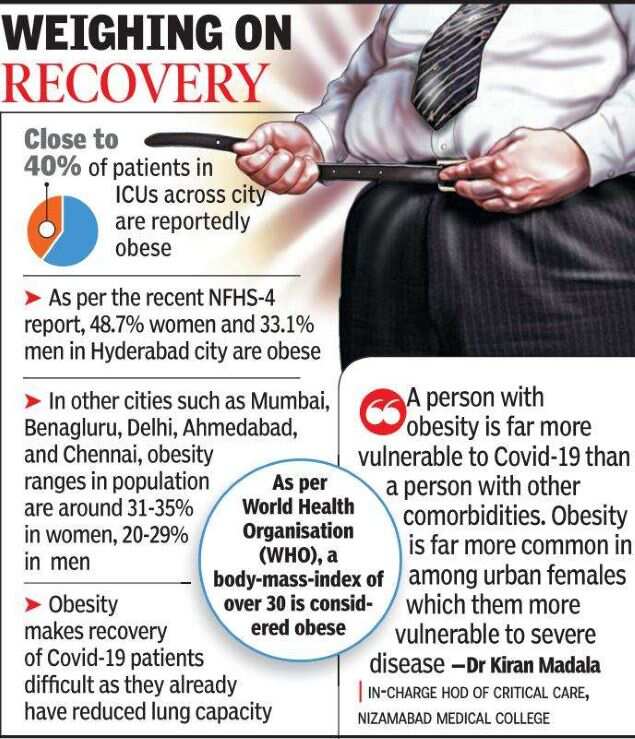Top Searches
- News
- City News
- Hyderabad News
- Covid-19 in Telangana: Obesity making recovery difficult for many
Covid-19 in Telangana: Obesity making recovery difficult for many

“If you see the Covid-19 death data, at least 50 per cent of deaths in females are among those who are obese,” said Dr Kiran Madala (Representative image)
HYDERABAD: Nearly 40 per cent of all critical Covid-19 patients in various intensive care units (ICU) across city hospitals are obese and doctors treating such patients across Telangana have said the high risk of severe Covid disease associated with obesity is also reflecting in the number of deaths.
According to the recent National Family Health Survey (NFHS-4) report, Hyderabad city alone has 48.7 per cent women and 33.1 per cent men under the overweight category, way higher than the numbers in Mumbai, Bangalore, Delhi, Ahmedabad, or Chennai. Across Telangana, 28 per cent of women and 24 per cent of men are overweight or obese.

“In ICU wards at least 40 per cent of patients fall in the category of obese or have other co-morbidities along with obesity” said a top resident doctor at Gandhi Hospital. At Telangana Institute of Medical Sciences and Research, one of the designated hospitals for Covid-19, handling mild to moderate cases, numbers are slightly lower.
“If you see the Covid-19 death data, at least 50 per cent of deaths in females are among those who are obese,” said Dr Kiran Madala, in-charge head of the department of critical care at the Nizamabad Medical College. While a Covid-19 patient having diabetes, hypertension or any other co-morbidity has a high risk of severe disease, obesity alone is the single highest risk factor.
In obese people, the vital capacity of the lungs — capacity to expand and contract — is lower. The abdominal fat also makes contraction difficult. “During this current wave, we are seeing 20 per cent of patients at our ICU with obesity. Among these patients, more incidents of metabolic or cardiovascular problems like stroke can be seen,” said TIMS superintendent Dr Ehsan Ahmed Khan.
Moreover, since obesity is invariably linked to other co-morbidities and raises inflammatory markers in the body, the virus makes use of these markers to cause more damage, said Dr Rahul Agarwal, consultant internal medicine.
“Many medicines do not work properly in obese patients as some doses are given as per body proportion. Again, when a patient is having low saturation, we usually put them on prone position (on the stomach) but for an obese patient it is a mechanical disadvantage and interferes with the process to increase oxygen flow in the blood,” added Dr Agarwal.
According to the recent National Family Health Survey (NFHS-4) report, Hyderabad city alone has 48.7 per cent women and 33.1 per cent men under the overweight category, way higher than the numbers in Mumbai, Bangalore, Delhi, Ahmedabad, or Chennai. Across Telangana, 28 per cent of women and 24 per cent of men are overweight or obese.

“In ICU wards at least 40 per cent of patients fall in the category of obese or have other co-morbidities along with obesity” said a top resident doctor at Gandhi Hospital. At Telangana Institute of Medical Sciences and Research, one of the designated hospitals for Covid-19, handling mild to moderate cases, numbers are slightly lower.
“If you see the Covid-19 death data, at least 50 per cent of deaths in females are among those who are obese,” said Dr Kiran Madala, in-charge head of the department of critical care at the Nizamabad Medical College. While a Covid-19 patient having diabetes, hypertension or any other co-morbidity has a high risk of severe disease, obesity alone is the single highest risk factor.
In obese people, the vital capacity of the lungs — capacity to expand and contract — is lower. The abdominal fat also makes contraction difficult. “During this current wave, we are seeing 20 per cent of patients at our ICU with obesity. Among these patients, more incidents of metabolic or cardiovascular problems like stroke can be seen,” said TIMS superintendent Dr Ehsan Ahmed Khan.
Moreover, since obesity is invariably linked to other co-morbidities and raises inflammatory markers in the body, the virus makes use of these markers to cause more damage, said Dr Rahul Agarwal, consultant internal medicine.
“Many medicines do not work properly in obese patients as some doses are given as per body proportion. Again, when a patient is having low saturation, we usually put them on prone position (on the stomach) but for an obese patient it is a mechanical disadvantage and interferes with the process to increase oxygen flow in the blood,” added Dr Agarwal.
FacebookTwitterLinkedinEMail
Start a Conversation
end of article
Trending Topics
Top Stories Right Now
- indiaUS jolted into action, Joe Biden phones PM Modi to promise all help
- cityCovid-19 surge: ‘Irresponsible’ EC should face murder charges, says Madras HC
- indiaLive: Gilead to give at least 450,000 vials of Remdesivir to India
- indiaIndia to receive first batch of Russia's Covid-19 vaccine on May 1: RDIF
- businessCurbs may hit supplies, fuel inflation: RBI